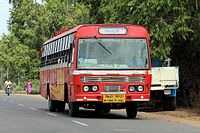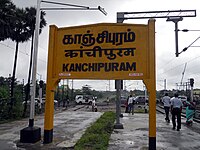Kanchipuram
Kanchipuram
Conjeevaram | |
|---|---|
UTC+5:30 (IST) | |
| PIN | 631501-631503 |
| Telephone code | 044 |
| Vehicle registration | TN-21 |
| Website | tnurbantree |
Kanchipuram (
Kanchipuram is a
In the Vaishnavism Hindu theology, Kanchipuram is one of the seven Tirtha (pilgrimage) sites, for spiritual release.[7] The city houses Varadharaja Perumal Temple, Ekambareswarar Temple, Kamakshi Amman Temple, and Kumarakottam Temple which are some of major Hindu temples in the state. Of the 108 holy temples of the Hindu god Vishnu, 15 are located in Kanchipuram.[8]
The city is most important to Sri Vaishnavism, Shaktism and then Shaivism. Most of the city's workforce is involved in the weaving industry.[9]
Kanchipuram is administered by a Special grade municipality constituted in 1947. It is the headquarters of the
Kanchipuram has been chosen as one of the heritage cities for
Etymology
Kanchipuram was known in early Tamil and Sanskrit literature as Kanchi or Kachipedu.[10] In the Sanskrit the word is split into two: ka and anchi. Ka means Brahma and anchi means worship,[citation needed] showing that Kanchi stands for the place where Varadharaja Perumal was worshipped by Brahma. Brahma has sculpted Athi Varadhar and worshipped here. In Sanskrit the term Kanci means girdle and explanation is given that the city is like a girdle to the earth.[11] The earliest Sanskrit inscriptions from the Gupta period (early 4th century-CE to late 5th century-CE) denote the city as Kanchipuram, where King Visnugopa was defeated by Samudragupta.[12] Patanjali (150 BCE or 2nd century BCE)[citation needed] refers to the city in his Mahabhasya as Kanchipuraka.[12] The city was referred to by various names like Kanchi, Kanchipedu and Kanchipuram.[10][12] The Pallava inscriptions from (250–355) and the inscriptions of the Chalukya dynasty refer the city as Kanchipura.[12] Jaina Kanchi refers to the area around Tiruparutti Kundram.[12] During the British rule, the city was known as Conjeevaram[1] and later as Kanchipuram. The municipal administration was renamed Kancheepuram, while the district and city retains the name Kanchipuram.[13][14]
It finds its mention in Pāṇini's Ashtadhyayi as Kanchi-prastha and in several Puranas. It is also one of the seven cities that provides liberation.[citation needed]
History

Kanchipuram Timeline | ||
400 — – 600 — – 800 — – 1000 — – 1200 — – 1400 — – 1600 — – 1800 — – 2000 — | Independent India | |
An approximate time-scale of Kanchipuram rulers. | ||
The earliest references to Kanchipuram are found in the books of the Sanskrit grammarian
Kanchipuram grew in importance when the Pallavas of southern
The Medieval Chola king
The
After the fall of the Vijayanagara Empire, Kanchipuram endured over two decades of political turmoil.
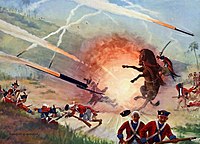
Kanchipuram was a battlefront for the
Geography
Kanchipuram is located at 12°50′19″N 79°42′06″E / 12.8387°N 79.7016°E, 72 km (45 mi) south-west of Chennai on the banks of the Vegavathi River, a tributary of the
- Big Kanchi, also called Shiva Kanchi, occupies the western portion of the city and is the larger of the two divisions;
- Little Kanchi, also called Vishnu Kanchi, is located on the eastern fringes of the city.[41][45]
Most of the Shiva temples were in Big Kanchipuram while most of the Vishnu temples were in Little Kanchipuram.[41]
Groundwater is the major source of water supplies used for irrigation – the block of Kanchipuram has 24 canals, 2809 tanks, 1878 tube wells and 3206 ordinary wells.[46] The area is rich in medicinal plants, and historic inscriptions mention the medicinal value.[47] Dimeria acutipes and Cynodon barberi are plants found only in Kanchipuram and Chennai.[48]
Climate
Kanchipuram has a
Most of the rain occurs in the form of cyclonic storms caused by depressions in the Bay of Bengal during the northeast monsoon.[49] Kanchipuram receives rainfall from both Northeast Monsoon and Southwest Monsoon. The highest single day rainfall recorded in Kanchipuram is 450 millimetres or 17.72 inches on 10 October 1943. The prevailing wind direction is south-westerly in the morning and south-easterly in the evening. In 2015, Kanchipuram district registered the highest rainfall of 182 centimetres or 71.65 inches in Tamil Nadu during Northeast Monsoon season. On 13 November 2015, Kanchipuram recorded a mammoth 340 millimetres or 13.39 inches of rain, thereby causing severe flooding.[50]
| Climate data for Kanchipuram, Tamil Nadu | |||||||||||||
|---|---|---|---|---|---|---|---|---|---|---|---|---|---|
| Month | Jan | Feb | Mar | Apr | May | Jun | Jul | Aug | Sep | Oct | Nov | Dec | Year |
| Mean daily maximum °C (°F) | 29.1 (84.4) |
31.2 (88.2) |
33.4 (92.1) |
35.6 (96.1) |
38.2 (100.8) |
37.2 (99.0) |
35.2 (95.4) |
34.7 (94.5) |
34.1 (93.4) |
32.1 (89.8) |
29.3 (84.7) |
28.5 (83.3) |
33.2 (91.8) |
| Mean daily minimum °C (°F) | 19.2 (66.6) |
19.8 (67.6) |
22.0 (71.6) |
25.4 (77.7) |
27.3 (81.1) |
27.0 (80.6) |
25.9 (78.6) |
25.4 (77.7) |
24.8 (76.6) |
23.7 (74.7) |
21.6 (70.9) |
19.9 (67.8) |
23.5 (74.3) |
| Average rainfall mm (inches) | 25 (1.0) |
6 (0.2) |
4 (0.2) |
19 (0.7) |
59 (2.3) |
77 (3.0) |
108 (4.3) |
173 (6.8) |
132 (5.2) |
185 (7.3) |
209 (8.2) |
107 (4.2) |
1,104 (43.4) |
| Source: Climate-Data.org[51] | |||||||||||||
Government and politics

| Municipal Corporation Officials | |
|---|---|
| [52]Mayor | M. Mahalakshmi |
| Corporation Commissioner | [53]G. Kannan |
| [54]Deputy Mayor | R. Kumaragurunathan |
| Elected Members | |
| Member of Legislative Assembly | C.V.M.P.Ezhilarasan[55] |
| Member of Parliament | G Selvam[56] |
The Kanchipuram municipality was officially constituted in 1866,
Kanchipuram comes under the
Policing in the city is provided by the Kanchipuram sub-division of the Tamil Nadu Police headed by a Deputy Superintendent of Police.[66] The force's special units include prohibition enforcement, district crime, social justice and human rights, district crime records and special branch that operate at the district level police division, which is headed by a Superintendent of Police.[66]
Demographics

| Year | Pop. | ±% |
|---|---|---|
| 1871 | 37,275 | — |
| 1881 | 37,312 | +0.1% |
| 1891 | 42,547 | +14.0% |
| 1901 | 46,164 | +8.5% |
| 1911 | 53,864 | +16.7% |
| 1921 | 61,376 | +13.9% |
| 1931 | 65,258 | +6.3% |
| 1941 | 74,685 | +14.4% |
| 1951 | 84,810 | +13.6% |
| 1961 | 92,714 | +9.3% |
| 1971 | 110,657 | +19.4% |
| 1981 | 131,013 | +18.4% |
| 1991 | 144,955 | +10.6% |
| 2001 | 153,140 | +5.6% |
| 2011 | 164,265 | +7.3% |
| Sources: | ||
During the rule of King Narasimha Varma in the 7th century, the city covered about 10 square kilometres (3.9 sq mi) and had a population of 10,000.
During the Chola era, Kanchipuram was not the capital, but the kings had a palace in the city and a lot of development was extended eastwards.[71] During the Vijayanagara period, the population rose to 25,000.[71] There were no notable additions to the city's infrastructure during British rule.[71] The British census of 1901 recorded that Kanchipuram had a population of 46,164, consisting of 44,684 Hindus, 1,313 Muslims, 49 Christians and 118 Jains.[21]
According to
Kanchipuram has 416 hectares (1,030 acres) of residential properties, mostly around the temples. The commercial area covers 62 hectares (150 acres), constituting 6.58% of the city. Industrial developments occupy around 65 hectares (160 acres), where most of the handloom spinning, silk weaving, dyeing and rice production units are located. 89.06 hectares (220.1 acres) are used for transport and communications infrastructure, including bus stands, roads, streets and railways lines.[78]
Economy


The major occupations of Kanchipuram are silk sari weaving and agriculture.[21] As of 2008, an estimated 5,000 families were involved in sari production.[79] The main industries are cotton production, light machinery and electrical goods manufacturing, and food processing.[80] There are 25 silk and cotton yarn industries, 60 dyeing units, 50 rice mills and 42 other industries in Kanchipuram.[81] Another important occupation is tourism and service related segments like hotels, restaurants and local transportation.[81]
Kanchipuram Saree
All major nationalised banks such as Vijaya Bank, State Bank of India, Indian Bank, Canara Bank, Punjab National Bank, Dena Bank and private banks like ICICI Bank have branches in Kanchipuram.[84] All these banks have their Automated teller machines located in various parts of the city.[84]
Human rights
Kanchipuram has more than the national average rate of child labour and bonded labour.[85][86] The local administration is accused of aiding child labour by opening night schools in Kanchipuram from 1999.[85] There is an estimated 40,000 to 50,000 child workers in Kanchipuram compared to 85,000 in the same industry in Varanasi.[86] Children are commonly traded for sums of between ₹ 10,000 and 15,000 (200 – $300) and there are cases where whole families are held in bondage.[86] Child labour is prohibited in India by the Children (Pledging of Labour) Act and Child Labour (Prohibition and Regulation) Act, but these laws are not strictly enforced.[87]
Transport, communication, and utility services
The Chennai – Bangalore National Highway,
The city is also connected to the railway network through the Kanchipuram railway station. The Chengalpet – Arakkonam railway line passes through Kanchipuram and travellers can access services to those destinations.[92] Daily trains are provided to Pondicherry and Tirupati, and there is a weekly express train to Madurai and a bi-weekly express train to Nagercoil.[93] Two passenger trains from both sides of Chengalpattu and Arakkonam pass via Kanchipuram.[89][93]
The nearest domestic as well as international airport is Chennai International Airport, located at a distance of 72 km from the city. The proposed New Chennai International Airport is to be built in Parandhur near Kanchipuram.
Telephone and broadband internet services are provided by
Education
Kanchipuram is traditionally a centre of religious education for the Hindu,[4][5] Jainism[6]
and Buddhism faiths.
As of 2011[update] Kanchipuram has 49 registered schools, 16 of which are run by the city municipality.[99] The district administration opened night schools for educating children employed in the silk weaving industry – as of December 2001, these schools together were educating 127 people and 260 registered students from September 1999.[85] Larsen & Toubro inaugurated the first rail construction training centre in India at Kanchipuram on 24 May 2012, that can train 300 technicians and 180 middle-level managers and engineers each year.[100] Sri Chandrasekharendra Saraswathi Viswa Mahavidyalaya and Chettinad Academy of Research and Education (CARE) are the two Deemed universities present in Kanchipuram.[101] The very famous 65-year-old college- founded by Vallal Pachaiyappar– Pachaiyappa's College for Men- is on the banks of Vegavathi River. It offers UG and PG courses in various subjects.It is the only Govt aided institute in Kanchipuram Taluk.
Kanchipuram is home to one of the four Indian Institute of Information Technology, a public private partnered institute, offering undergraduate and post graduate programs in information technology.[102] The city has two medical colleges – Arignar Anna Memorial Cancer Institute and Hospital, established in 1969, is operated by the Department of Health, Government of Tamil Nadu[103] and the privately owned Meenakshi Medical College.[104] The city has 6 engineering colleges,[105] 3 polytechnic institutes and 6 arts and science colleges.[106]
Religion
Hinduism
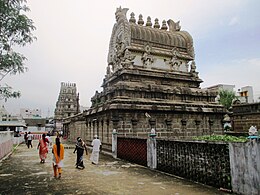
Hindus regard Kanchipuram to be one of the seven holiest cities in India, the
Tiru Parameswara Vinnagaram The central shrine has a three-tier shrine, one over the other, with Vishnu depicted in each of them.[114] The corridor around the sanctum has a series of sculptures depicting the Pallava rule and conquest.[114] It is the oldest Vishnu temple in the city and was built by the Pallava king Paramesvaravarman II (728–731).[114]
In the
Muktheeswarar Temple, built by

The
Another matha which was famous in ancient times was the Upanishad Bramham Mutt, located near Kailasanathar temple, Kanchipuram. It has the Mahasamadhi of Upanishad Brahmayogin, a saint who wrote commentaries on all the major Upanishads in Hinduism. It is said that the great Sage, Sadasiva Brahmendra took to sanyasa at this matha.
Injimedu is also called Yagna Vedhikai, as many yagna rituals are performed in the village. It is located at 3 km from Pernamallur Town. The best route to go injimedu is
- Kanchipuram-Cheyyaru-Pernamallur-Injimedu
- Tambaram-Uthiramerur-Vandavasi-Mazhaiyur(Chetpet Road)-Chinna kozhipuliyur-Injimedu.
Buddhism
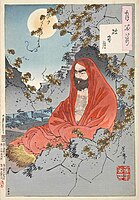
Buddhism is believed to have flourished in Kanchipuram between the 1st and 5th centuries.
A number of bronzes unearthed at Kurkihar (Apanaka Vihara, near Gaya in Bihar) mention that the majority of the donors were from Kanchi, indicating that Kurkihar was a major center for the visitors from Kanchi during 9th to 11th century,
Jainism

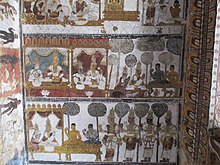
Kanchipuram had been a major center of Jainism and is associated with several well-known Jain Acharyas like Samantabhadra and
The original set of the
Other religions
The city has two mosques; one near the Ekambareswarar temple, was built during the rule of Nawab of Arcot in the 17th century, and another near the Vaikunta Perumal temple, shares a common tank with the Hindu temple. Muslims take part in the festivals of the Varadharaja (Swamy) temple.[137] Christ Church is the oldest Christian church in the city. It was built by a British man named Mclean in 1921. The church is built in Scottish style brick structure with arches and pillars.[137]
See also
- Kammavarpalayam
- Murugan Temple, Saluvankuppam
- Sri Jayendra Saraswathi Silver Jubilee School, Tirunelveli
Notes
Footnotes
- ^ The official spelling, as per the municipality website, is "Kancheepuram".[138] However, the spelling Kanchipuram is the most widely used name.
Citations
- ^ a b Malalasekera 1973, pp. 112–13.
- ^ a b Kanchipuram : Census 2011.
- ^ a b Chisholm, Hugh, ed. (1911). . Encyclopædia Britannica. Vol. 6 (11th ed.). Cambridge University Press. p. 943.
- ^ a b Rao 2008, p. xviii.
- ^ a b K.V. 1975, p. 80.
- ^ a b c d Thapar 2001, pp. 344–345.
- ISBN 978-1-62356-623-4.
- ^ Gupta 2001, p. 51.
- ^ Kanchipuram Industrial profile 2012.
- ^ a b K.V. 1975, p. 6.
- ^ http://shodhganga.inflibnet.ac.in/bitstream/10603/39511/7/07_chapter%202.pdf Archived 17 July 2018 at the Wayback Machine p.no 7
- ^ a b c d e Sharma 1978, p. 255.
- ^ a b c About municipality 2011.
- ^ a b c d e f g h i j k l m n o p q r s t u v w x y z aa ab K.V. 1975, pp. 26–39.
- ^ a b c Iyengar 1929, pp. 322–333.
- ^ Historical Importance of Kanchipuram 2011.
- ISBN 978-93-83440-34-4.
- ^ Kamath 2000, p. 127.
- ^ Hoiberg 2000.
- ^ Pochhammer 2005, p. 99.
- ^ a b c d e f Imperial Gazetteer of India 1908, pp. 544–546.
- ^ a b Keay 2001, p. 170.
- ^ Sastri 2008, p. 136.
- ^ Jouveau-Dubreuil 1994, p. 71.
- ^ Smith 1914, p. 473.
- ^ Sastri 1935, p. 113.
- ^ Aiyangar 2004, p. 60.
- ^ a b K.V. 1975, pp. 11–26.
- ^ a b Rao 2008, p. 126.
- ^ Rao 2008, p. 127.
- ^ Sastri 1935, p. 210.
- ^ Sastri 1935, p. 420.
- ^ Aiyangar 2004, p. 34.
- ^ Sastri 1935, p. 428.
- ^ Aiyangar 2004, p. 49.
- ^ Aiyangar 2004, p. 61.
- ^ K.V. 1975, p. 48.
- ^ Jaques 2007, p. 257.
- ^ R.G. 2011, p. 468.
- ^ a b c About City 2011.
- ^ a b c d e K.V. 1975, pp. 1–4.
- ^ Srinivasan 1979, p. 6.
- ^ Seismic Zoning map 2008.
- ^ Seismology glossary 2008.
- ^ Browne 1843, p. 228.
- ^ Ministry of Water Resources, Government of India 2007, p. 5.
- ^ The Hindu & 19 May 2012.
- ^ The Hindu & 18 June 2012.
- ^ a b c d e f Ministry of Water Resources, Government of India 2007, p. 6.
- ^ Kanchipuram local plan 2006, p. 1.
- ^ "CLIMATE: KANCHEEPURAM". Archived from the original on 2 March 2016. Retrieved 19 February 2016.
- ^ Kanchipuram Municipality – Chairman 2011.
- ^ Kanchipuram Municipality – Commissioner 2011, p. 54.
- ^ Vice-Chairman of Kanchipuram municipality 2011.
- ^ a b MLA of Kanchipuram 2011.
- ^ a b MP of Kanchipuram 2019.
- ^ List of municipalities in Tamil Nadu 2011.
- ^ a b Commissionerate of Municipal Administration 2011.
- ^ Economic and political weekly 1995, p. 2396.
- ^ Shanmughasundaram, J. (24 August 2021). "Tambaram, Kancheepuram and four other municipalities to be corporations". The Times of India. Chennai: The Times Group. Retrieved 29 September 2021.
- ^ a b c Election Report – Full Statistical Report 2011.
- ^ rediff & 7 May 2009.
- ^ Kannan 2010, p. 5.
- ^ Frontline & 23 April 2004.
- ^ Chakrabarty 2008, pp. 110–111.
- ^ a b Kanchipuram district police 2011.
- ^ Hunter 1885.
- ^ Kanchipuram Master Plan 2001.
- ^ a b Kanchipuram population 2012.
- ^ Rao 2008, p. 142.
- ^ a b c d e f g Rao 2008, p. 143.
- ^ a b c d Ayyar 1991, p. 69.
- ^ "India - C-16: Population by mother tongue, Tamil Nadu - 2011". Archived from the original on 30 July 2022.
- ^ a b National Sex Ratio 2011.
- ^ Kanchipuram 2011 census.
- ^ Rao 2008, p. 145.
- ^ Population by religion 2013.
- ^ Kanchipuram local plan 2006, pp. 7–9.
- ^ a b c d e Rao 2008, pp. 134–135.
- ^ Husain 2011, p. 11.K.4.
- ^ a b Industries in Kanchipuram 2011.
- ^ The Economic Times & 27 December 2011.
- ^ The Times of India & 29 August 2010.
- ^ a b Kanchipuram City Banks 2011.
- ^ a b c Human Rights Watch 2003, p. 62.
- ^ a b c Human Rights Watch/Asia 1995, p. 82.
- ^ Human Rights Watch/Asia 1995, p. 88.
- ^ Rao 2008, p. 3.
- ^ a b c Bus routes, Train schedules, Air schedules 2011.
- ^ TNSTC Villupuram 2011.
- ^ Kanchipuram local plan 2006, p. 10.
- ^ Rao 2008, p. 4.
- ^ a b Train Running Information 2012.
- ^ BSNL 2011.
- ^ TNEB region details 2011.
- ^ Kanchipuram water supply 2011.
- ^ Waste management programme 2011.
- ^ Kanchipuram sewage and sanitation 2011.
- ^ Educational institutes of Kanchipuram 2011.
- ^ The Businessline & 24 May 2012.
- ^ Deemed University list 2012.
- ^ The Indian Express & 29 May 2012.
- ^ TN Health Department – Arignar Anna Memorial Cancer Institute and Hospital 2012.
- ^ Meeenakshi Medical College and Research Institute 2012.
- ^ AICTE list of approved institutes 2012.
- ^ University of Madras – affiliated colleges 2012.
- ^ Gopal 1990, p. 177.
- ^ Rajarajan, R.K.K. (2007) Early Historical Setting of Kañci and its Temples. Journal of the Institute of Asian Studies 25.1: 23–52. Regd. No. 156167/85/M2.
- ^ Ramesh, M.S. (1993). 108 Vaishnavite Divya Desams volume one Divyadesams in Tondai Nadu. Tirpuati: Tirupati Tirumala Devastanams. p. 44.
- ^ Ramaswamy 2007, p. 273
- ^ "Abodes of Vishnu – Thirukkachchi".
- ^ "Divya Desams of Lord Vishnu". Archived from the original on 3 June 2013. Retrieved 17 May 2013.
- ^ Gateway to Kanchipuram district – Varadaraja Temple 2011.
- ^ a b c d Ayyar 1991, p. 80.
- ^ Ayyar 1991, p. 539.
- ^ Rao 2008, p. 109.
- ^ Let's Go 2004, p. 584.
- ^ a b Ramaswamy 2007, pp. 301–302.
- ^ a b Ayyar 1991, p. 73.
- ^ Ayyar 1991, pp. 70–71.
- ^ Tourist places in Kanchipuram 2012.
- ^ a b c Ayyar 1991, p. 86.
- ^ Soundara Rajan 2001, p. 27.
- ^ Rao 2008, p. 110.
- ^ Saraswati 2001, p. 492.
- ^ a b Dalal 2006, p. 186.
- ^ a b Kuttan & Arunachalam 2009, pp. 244–245.
- ^ Sharma 1987, pp. 44–46.
- ^ Trainor 2001, p. 13.
- ^ a b c d e f Rao 2008, p. 20.
- ^ Zvelebil 1987, p. 125-126.
- ^ McRae 2000, p. 26.
- ^ Harvey 2000, p. 56.
- ^ Smith 1914, p. 468.
- ^ The Hindu & 23 June 2011.
- ^ Tamilnadu Digambar Jain Tirthakshetra Sandarshan, Bharatvarshiya Digambar Jain Tirtha Samrakshini MahaSabha, 2001
- ^ a b Religious places in Kanchipuram 2011.
- ^ "About us". Kancheepuram municipality. Archived from the original on 7 January 2012.
References
- Seismic Zoning Map (Map). India Meteorological Department. 2008. Archived from the original on 3 June 2014. Retrieved 12 November 2012.
- Seismology glossary (PDF) (Report). India Meteorological Department. 2008. Archived from the original (PDF) on 29 September 2011. Retrieved 12 November 2012.
- Kanchipuram local plan (2006). Kanchipuram local plan (PDF) (Report). Kancheepuram Municipality. Retrieved 8 June 2012.
- Ministry of Water Resources, Government of India (2007). District ground water brochure – Kancheepuram district (PDF) (Report). Ministry of Water Resources, Government of India. Retrieved 30 September 2012.
- "Nanmangalam forest will get wall as shield". The Times of India. 18 June 2012. Archived from the original on 12 June 2013. Retrieved 26 June 2012.
- "Medicinal garden set up near Kancheepuram". The Hindu. 19 May 2012. Retrieved 26 June 2012.
- "Deprived of original élan". The Hindu. 23 June 2011. Retrieved 26 June 2012.
- Dave, Kapil (29 May 2012). "Govt ropes in TCS for much-awaited IIIT project". The Indian Express. Chennai. Retrieved 15 June 2012.
- T.E., Raja Simhan (24 May 2012). "L&T opens first rail construction training centre near Chennai". The Business Line. Chennai. Retrieved 15 June 2012.
- "GI tag: TN trails Karnataka with 18 products". The Times of India. 29 August 2010. Archived from the original on 3 November 2012. Retrieved 26 June 2012.
- Sangeetha Kandavel, Sanjay Vijyakumar (27 December 2011). "Government eases norms for gold-silver mix in Kanchipuram sarees". The Economic Times. Chennai. Retrieved 14 May 2012.
- "Kancheepuram weavers disillusioned". rediff. 7 May 2009. Retrieved 8 June 2012.
- Viswanathan, S (23 April 2004). "A history of agitational politics". Frontline, The Hindu publishing. Archived from the original on 2 March 2008. Retrieved 19 December 2008.
- "Population By Religious Community – Tamil Nadu" (XLS). Office of The Registrar General and Census Commissioner, Ministry of Home Affairs, Government of India. 2011. Retrieved 13 September 2015.
- "Census Info 2011 Final population totals – Kanchipuram". Office of The Registrar General and Census Commissioner, Ministry of Home Affairs, Government of India. 2013. Archived from the original on 24 September 2015. Retrieved 26 January 2014.
- "Census Info 2011 Final population totals". Office of The Registrar General and Census Commissioner, Ministry of Home Affairs, Government of India. 2013. Retrieved 26 January 2014.
- "Religious places in Kanchipuram". Tamil Nadu Tourism Development Corporation. 2011. Retrieved 26 June 2012.
- "University of Madras – affiliated colleges". University of Madras. 2012. Retrieved 8 June 2012.
- "AICTE list of approved institutes". AICTE. 2012. Retrieved 8 June 2012.
- "Arignar Anna Memorial Cancer Institute and Hospital". Department of Health, Government of Tamil Nadu. 2012. Archived from the original on 31 August 2012. Retrieved 8 June 2012.
- "Meeenakshi Medical College and Research Institute". Meenakshi Medical College. 2012. Retrieved 8 June 2012.
- "Deemed University List". University Grants Commission. 2012. Retrieved 8 June 2012.
- "Train Running Information". Indian Railways. 2012. Retrieved 8 June 2012.
- "TNSTC Villupuram". Tamil Nadu State Transport Corporation. 2011. Retrieved 8 June 2012.
- "Educational institutes of Kanchipuram". Kanchipuram Municipality. 2011. Archived from the original on 18 December 2012. Retrieved 8 June 2012.
- "Kanchipuram district police" (PDF). Tamil Nadu Police. 2011. Retrieved 26 June 2012.
- "Kanchipuram City Banks". Kanchipuram Municipality. 2011. Archived from the original on 18 December 2012. Retrieved 8 June 2012.
- "Bus routes, Train schedules, Air schedules". Kanchipuram Municipality. 2011. Archived from the original on 18 December 2012. Retrieved 8 June 2012.
- "About City". Government of Tamil Nadu. 2011. Archived from the original on 27 December 2011. Retrieved 26 June 2012.
- "Tourist places in Kanchipuram". National Informatics centre. 2012. Archived from the original on 23 April 2012. Retrieved 26 June 2012.
- "Historical Importance of Kanchipuram". National Informatics centre. 2011. Archived from the original on 18 May 2006. Retrieved 26 June 2012.
- "Kanchipuram population". Kanchipuram municipality. 2012. Archived from the original on 18 December 2012. Retrieved 14 September 2012.
- "Region Details". Tamil Nadu Electricity Board. 2011. Retrieved 26 June 2012.
- "Solid waste management". India: Kanchipuram Municipality. 2011. Archived from the original on 29 December 2009. Retrieved 13 September 2012.
- "Kanchipuram water supply". India: Kanchipuram Municipality. 2011. Archived from the original on 6 March 2014. Retrieved 13 September 2012.
- "Kanchipuram sewage and sanitation". India: Kanchipuram Municipality. 2011. Archived from the original on 29 December 2009. Retrieved 13 September 2012.
- "State of Rural wireline broadband". Tamil Nadu: BSNL, Tamil Nadu Circle. 2011. Archived from the original on 18 July 2013. Retrieved 26 June 2012.
- "Kanchipuram Industrial profile". Department of Industries and Commerce district industries centre, Kanchipuram District. 2012. Retrieved 26 June 2012.
- "Kanchipuram Municipality – Chairman". Kanchipuram Municipality, Government of Tamil Nadu. 2011. Archived from the original on 11 January 2011. Retrieved 26 June 2012.
- "Kanchipuram Municipality – Commissioner". Kanchipuram Municipality, Government of Tamil Nadu. 2011. Archived from the original on 18 February 2010. Retrieved 26 June 2012.
- "Vice Chairman of Kanchipuram municipality". Kanchipuram Municipality, Government of Tamil Nadu. 2011. Archived from the original on 2 February 2009. Retrieved 26 June 2012.
- "MLA of Kanchipuram". Government of Tamil Nadu. 2011. Retrieved 26 June 2012.
- "Members of parliamentary constituencies in Tamil Nadu". Government of Tamil Nadu. 2014. Retrieved 26 May 2014.
- "List of municipalities in Tamil Nadu". Commissionerate of Municipal Administration, Government of Tamil Nadu. 2011.
- "About municipality". Commissionerate of Municipal Administration, Government of Tamil Nadu. 2011. Archived from the original on 21 February 2012. Retrieved 26 June 2012.
- "Commissionerate of Municipal Administration". Commissionerate of Municipal Administration. 2011. Archived from the original on 6 November 2012. Retrieved 26 June 2012.
- "Election Report – Full Statistical Report". Election Commission of India. 2011. Retrieved 26 June 2012.
- "Kanchipuram : Census 2011". Population Census India (web), Ministry of Home Affairs. 2001. Retrieved 26 June 2012.
- "Kanchipuram Master Plan" (PDF). Government of Tamil Nadu. 2001. Retrieved 26 June 2012.
- "Industries in Kanchipuram". Kanchipuram Municipality, Government of Tamil Nadu. 2011. Archived from the original on 19 December 2012. Retrieved 26 June 2012.
- "Gateway to Kanchipuram district – Varadaraja Temple". Kanchipuram District administration. 2011. Archived from the original on 30 July 2013. Retrieved 26 June 2012.
- Aiyangar, Sakkottai Krishnaswami (2004). Ancient India: Collected Essays on the Literary and Political History of. New Delhi: Asian Educational Services. ISBN 81-206-1850-5.
- Ayyar, P. V. Jagadisa (1991). South Indian shrines: illustrated. New Delhi: Asian Educational Services. ISBN 81-206-0151-3.
- Browne, Charles Alfred (1843). An introduction to the geography and history of India, and the countries. P.R. Hunt, American Mission Press. p. 228.
- Chakrabarty, Bidyut (2008). Indian Politics and Society Since Independence. Routledge. pp. 110–111. ISBN 978-0-415-40868-4.
- Dalal, Roshan (2006). The Religions of India: A Concise Guide to Nine Major Faiths. Penguin Books India. ISBN 978-0-14-341517-6.
- Economic and political weekly (1995). Economic and political weekly, Volume 30. Sameeksha Trust. p. 2396.
- Gopal, Madan (1990). K.S. Gautam (ed.). India through the ages. Publication Division, Ministry of Information and Broadcasting, Government of India.
- Gupta, Subhadra Sen (2001). Tirtha: holy pilgrim centres of the Hindus : saptapuri & chaar dhaam. Rupa & Co. p. 56. ISBN 81-7167-564-6.
- Kuttan, Mahadevan; Arunachalam, P.V. (2009). The Great Philosophers of India. Author House. ISBN 978-1-4343-7780-7.
- Human Rights Watch (January 2003). Human Rights Watch, The small hands of slavery: Bonded Child Labour in India. hrw.org. Retrieved 12 June 2012.
- Human Rights Watch/Asia (1995). Human Rights Watch, The small hands of slavery: Bonded Child Labour in India. hrw.org. ISBN 1-56432-172-X.
- Husain, Majid (2011). Understanding: Geographical: Map Entries: for Civil Services Examinations. Tata McGraw Hill. ISBN 978-0-07-070288-2.
- Hunter, W. W. (1885). Imperial Gazetteer of India. Vol. 6 (2 ed.). London: Trubner & Co.
- Hoiberg, Indu Ramchandani (2000). Student's Britannica: India (Set of 7 Vols.) 39. Vol. 7. New Delhi: Encyclopædia Britannica (India) Private Limited. ISBN 0-85229-760-2.
- Imperial Gazetteer of India (1908). Madras: The presidency; mountains, lakes, rivers, canals, and historic areas – Provincial Series Madras. Calcutta: Superintendent of Government Printing.
- ISBN 978-81-206-0145-1.
- Jaques, Tony (2007). Dictionary of Battles and Sieges. Vol. 3. Bloomsbury Academic. ISBN 978-0-313-33536-5.
- Jouveau-Dubreuil, Tony (1994). The Pallavas. New Delhi: Asian Educational Services. ISBN 81-206-0574-8.
- Kamath, Rina (2000). Chennai. Orient Longman Limited. ISBN 81-250-1378-4.
- Kannan, R. (2010). Anna: The Life and Times of C.N. Annadurai. Penguin Books India. ISBN 978-0-670-08328-2.
- Keay, John (2001). India: A History. Grove Press. ISBN 0-8021-3797-0.
- Harvey, G.E (2000). History of Burma. Asian Educational Services. ISBN 9788120613652.
- K.V., Raman (1975). Sri Varadarajaswami Temple, Kanchi: A Study of Its History, Art and Architecture. New Delhi: Abhinav Publications. ISBN 8170170265.
- Let's Go (2004). Let's Go India & Nepal 8th Edition. NY: Let's Go Publications. ISBN 0-312-32006-X.
- Malalasekera, G.P. (1973). The Pali Literature of Ceylon. Colombo: Buddhist Publication Society. pp. 112–113. ISBN 955-24-0118-6.
- McRae, John R. (2000). "The Antecedents of Encounter Dialogue in Chinese Ch'an Buddhism". In Heine, Steven; Wright, Dale S. (eds.). The Kōan: Texts and Contexts in Zen Buddhism. Oxford University Press.
- Pochhammer, Wilhelm von (2005). India's Road to Nationhood: A Political History of the Subcontinent. Mumbai: Allied Publishers (P) Ltd. ISBN 81-7764-715-6.
- Rao, P.V.L. Narasimha (2008). Kanchipuram – Land of Legends, Saints & Temples. New Delhi: Readworthy Publications (P) Ltd. ISBN 978-93-5018-104-1.
- R.G., Grant (2011). 1001 Battles That Changed the Course of World History. United States: Random House Digital, Inc. ISBN 9780789322333.
- Ramaswamy, Vijaya (2007). Historical dictionary of the Tamils. United States: Scarecrow Press, INC. ISBN 978-0-470-82958-5.
- Sastri, K. A. Nilakanta (2008). A History of South India (4th ed.). New Delhi, India: Oxford University Press.
- Sastri, K. A. Nilakanta (1935) [1935]. The Cōlas. Madras: University of Madras.
- Saraswati, Prakashanand (2001). The True History and the Religion of India: A Concise Encyclopedia of (1st ed.). New Delhi, India: Motilal Banarsidass. ISBN 81-208-1789-3.
- Sharma, Varanasi Raj Gopal (1987). Kanchi Kamakoti Math, a myth. Ganga-Tunga Prakashan. ISBN 0-415-40868-7.
- Sharma, Tej Ram (1978). Personal and Geographical Names in the Gupta Inscriptions. Concept Publishing Company. p. 255. ISBN 0-415-40868-7.
- Smith, Vincent Aruthur Smith (1914). The Early History of India from 600 B.C. to the Muhammadan Conquest including the invastion of Alexander the Great (3rd ed.). Clarendon Press.
- Soundara Rajan, Kodayanallur Vanamamalai (2001). Concise classified dictionary of Hinduism. New Delhi: Concept Publishing Company. ISBN 81-7022-857-3.
- Srinivasan, C. R. (1979). Kanchipuram through the ages. Agam Kala Prakashan.
- Thapar, Romila (2001). Early India: From the Origins to AD 1300. California: University of California Press. ISBN 0-520-24225-4. Retrieved 15 June 2012.
- Trainor, Kevin (2001). Buddhism The Illustrated Guide. New York: Oxford University Press. ISBN 0-19-517398-8.
- JSTOR 602960.
External links

